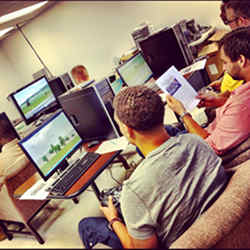
Over the last few years, unmanned aerial vehicles (UAVs) — also known as drones — have flown beyond the battlefield and into commercial use. Agricultural scientists, movie production companies, and oil exploration teams already rely on these aircraft to accomplish a variety of tasks, provided they are able to obtain government approval.
Many other industries, such as real estate, firefighting, and law enforcement have their eyes on the technology. The Association for Unmanned Vehicle Systems (AUVSI) reports that commercial drones could add $13.6 billion to the U.S. economy between this year and 2018. In addition, over the next decade, commercial drones could generate more than 100,000 new jobs.
As the concept takes flight–the U.S. Federal Aviation Administration (FAA) is scheduled to issue legal guidelines for commercial use of drones weighing 55 pounds or less in September—there is a piece of the puzzle that must be addressed: how to train humans to operate and fly unmanned aerial systems (UAS), which include ground-based systems and other technologies that connect to these aircraft wirelessly. "There will likely be explosive growth associated with drones. Organizations from a wide range of industries and government will require these skills," says Dan Macchiarella, professor and chair of Aeronautical Science at Embry-Riddle Aeronautical University.
As a result, a growing number of public and private schools are introducing academic programs and degrees that teach individuals how to pilot commercial drones, skills that will help them achieve incomes of between $50,000 and $80,000 a year. As government requirements emerge and specific licensing requirements become clear, universities, colleges, and trade schools will continue to boost these offerings. "This is an industry that will generate enormous revenues and fundamentally change business," says Darrell Slaughter, director of business development at Unmanned Vehicle University. "In a few years, drones will touch almost every part of our lives."
Sky High Expectations
Clearly, a new era is emerging. Although no specific standards exist for schools and certifications, many are forging ahead. For instance, Embry-Riddle introduced a bachelor’s degree in unmanned aircraft systems science in 2011. Prior to that, the school offered several classes and a minor in the subject. Just over 200 students have enrolled in the program; Macchiarella says the gender ratio is about 60% male/40% female. The bachelor’s degree requires 122 credit hours of study and focuses on an array of issues, including communications, digital circuitry, hazardous operations, multispectral imaging, sensing systems, surveillance and data collection, secure operations, long duration operations, highly repetitive operations, and autonomous operations.
The university uses a learning model introduced by the U.S. military. "The aim is to produce a professional-level pilot," Macchiarella says. Students learn through traditional coursework, as well as through the use of simulators. Inside the Line-Oriented Flight Training (LOFT) simulator, they fly complex virtual missions that involve other aircraft and realistic situations, such as a forest fire or an oil spill at sea. Students only occasionally fly actual aircraft, and that takes place in restricted areas. "Because of current FAA restrictions, we are on a very tight leash," he explains.
At Unmanned Vehicle University, which offers a certificate program as well as bachelor’s and master’s degrees for operating and flying UAVs (the school is currently developing a doctorate of science program as well), the emphasis is on lectures, videos, PowerPoint presentations, and time in a flight simulator. Students plug a handheld UAV controller into the USB port of a computer and use software to manipulate a vehicle. "It’s actually more difficult to fly the simulator than an actual UAV. When you master the simulator, you are a competent pilot," Slaughter says. He adds that young people who have grown up with video games often possess the right skills for operating commercial drones.
However, four-year universities and specialty schools are not the only places offering UAV instruction and degrees. Central Oregon Community College (COCC) offers an associate’s degree related to UAVs, and aviation program director Karl Baldessari (once a U.S. Coast Guard pilot) sees rapidly growing interest in the field. "About three years ago, we began exploring the idea of providing coursework revolving around the commercial use of unmanned aerial systems. We are already seeing job opportunities pop up and significant interest in the field," he says. "Once the FAA lays down guidelines, the industry is poised for enormous growth."
COCC uses a simulator developed by Boeing subsidiary Insitu, which closely replicates real-world conditions. More than 90% of the training takes place behind the console. Instructors assign students missions, which they embark on while sitting in a simulator located in a trailer. "Flying a drone is a robotic and virtual process, so in this scenario, a simulator provides a realistic experience and the learning necessary to operate a UAV in the real world," Baldessari says. The simulator and related programs undergo constant updates and tweaks, he says, adding, "When the FAA finalizes its guidelines, the program will undergo further changes."
The Future Unfolds
Over the next few years, Slaughter and others see UAS instruction emerging as a standard part of college curricula. Schools are anxiously awaiting final rules and licensing requirements for commercial drone operators–including whether the FAA will require a commercial pilot license in order to operate unmanned commercial vehicles and, if so, what shape and form such a license will take. Also not clear is what certification standards, if any, will appear. The European Union and various other countries also are grappling with many of the same issues.
Says Baldessari, "There are a lot of questions about rules and restrictions, and safety and other issues related to airspace. These will be sorted out over time. The bottom line is that UAS is emerging as a viable new field and it’s critical to train people how to manage and fly these aircraft."
Samuel Greengard is an author and journalist based in West Linn, OR.



Join the Discussion (0)
Become a Member or Sign In to Post a Comment